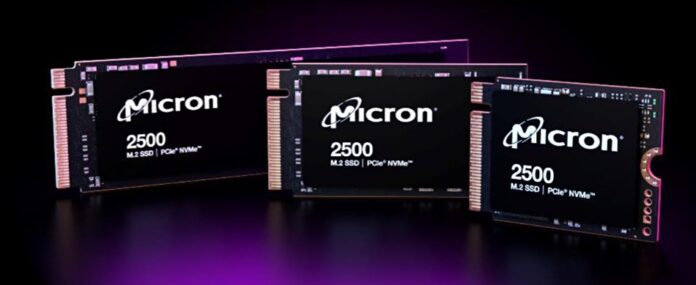Micron has launched a 2500 QLC NAND internal fit client product that’s faster than its 2550 TLC predecessor, despite TLC NAND typically being quicker than QLC NAND.
TLC (triple level cell) NAND has 3 bits per cell while QLC (quad level cell) has 4 bits per cell, meaning the SSD’s controller has to negotiate QLC’s 16 voltage states per cell instead of 8 with TLC. It takes longer to read and write individual cells unless the controller firmware gets clever with such things as a very fast SLC (1 bit/cell) cache, and parallel data plane access.
Micron’s 2500 is claimed to be the first 200-plus layer QLC drive for OEM desktop and notebook (client) computers. It uses 232-layer QLC NAND, and this gives it 30 percent more density, Micron says, than its 2400 176-layer QLC product, and 31 percent more than its 232-layer TLC NAND, as used in the 2550 M.2 format SSD. This was launched in December 2022 so it has taken 16 months to add the extra bit to the 232-layer NAND cells used in the 2500.
The 2500 is also quicker performing than the 2450 176-layer TLC product from 2021, with 24 percent faster reads and 31 percent faster write performance. Overall, Micron claims the 2500 has best-in-class “performance that beats competitive TLC and QLC-based SSDs,” meaning better than its top five client OEM competitor products.
A table compares the performance of Micron’s recent M.2 format SSDs:

This shows that the 2500 effectively replaces the slower 2550, providing higher capacity, more IOPS, and better bandwidth. It’s even nudging up against the high-end 3500, which also uses 232-layer flash, and in fact provides faster sequential reads – 7.1 GBps versus the 3500’s 7 GBps.
Micron says the 2500 has an up to 45 percent better PC Mark10 benchmark score than three competing TLC products.
The 2500 is available in small (22 x 30 mm), medium (22 x 42 mm), and large (22 x 80 mm) M.2 formats. It is a PCIe gen 4 x 4 lane drive, using an NVMe v1.4 interface, like the other Micron M.2 drives mentioned, but the later v1.4c variant. The drive uses host-memory buffer technology, meaning there is no DRAM in the drive itself, like its predecessor.
The drive’s endurance (TBW meaning terabytes written) varies with capacity over the five-year warranty period, with a 2 million hours MTTF rating:
- 512 GB – 200 TBW
- 1 TB – 300 TBW
- 2 TB – 600 TBW
It sips electricity, using less than 2.5 mW in sleep power state, less than 150 mW in active idle power state, and less than 6,300 watts in its active power state.
Micron classifies the 3500 as being a performant drive for data-intensive workloads, the 2550 as a mainstream workload drive, and the 2500 is a “value QLC SSD at TLC performance” levels. We think it could replace the 2550 and overlap with the 3500.








